It was raining goals for the visitors as it turned out to be one of the most entertaining games in Serie A in recent times. Sassuolo’s energetic play proved to be the deciding factor in their victory against the fourth-place home club, who aim for a spot in the Champions League.
The Italian manager Stefano Pioli made a name for himself on the field as a central defender—a position the Italians have always prized as the “stopper,” or last defender. Italy’s history with its defenders is a fascinating and distinctive tale in and of itself.
With their recent losing streak continuing, Milan has now lost four of their previous six games and drawn two others. They drew with Roma and Lecce but lost to Torino in the Coppa Italia and to Inter and Lazio, who take second and third respectively in the league.
Although Pioli has earned a lot of respect, he is generally considered to be a nomad at best. The 54-year-old has been bouncing among Italian clubs like Lazio, Fiorentina, and Inter Milan for nearly 20 years, but failed to win a major title with any of them.
As a result of his ineffectiveness in his first season with the Rossoneri, AC Milan ranked sixth in the league table. However, they came out strong the following year, finishing in second place in the league for the first time since 2012–13.
Sassuolo’s 42-year-old Alessio Dionisi began his managerial career in 2014 after a few disappointing years as a player. A new head coach position at Serie B club Empoli was revealed for him in 2020 after he had garnered interest for a while.
His first season at the helm saw Empoli win Serie B and secure automatic promotion to Serie A. His strong performance at Empoli led to Serie A club Sassuolo offering him the vacant job of head coach after Roberto De Zerbi’s transfer.
Dionisi has managed 62 games for Sassuolo and has a dismal 30.65 win %. In all, he has only pulled off 19 successful wins out of the pot. But following his takeover, the team’s failure to score goals has lost its significance and is now proving to be a favourable indication.
As a race, the Neroverdi have had a mixed season thus far. Dionisi’s squad has seen everything this season, from coming from behind to squandering huge leads. But what’s more crucial is that now, with more data available, patterns of improvement are much more apparent.
After losing four in a row, Sassuolo played considerably better last weekend, tying 1-1 with Monza, who shocked Juventus by beating them at Allianz Stadium, further damaging the faltering Bianconeri’s chances of a comeback.
This tactical analysis will show how Sassuolo completely neutralised Milan’s style of play and controlled the contest. This analysis would also include the tactics used by both managers.
Lineups
It was a 4-2-3-1 configuration used by both coaches. For the season as a whole, Pioli has used this formation 74% of the time, making it his favourite. Between the sticks stood the Romanian Anton Tătărușanu.
To man the middle of the defence, we have Matteo Gabbia on the left and Pierre Kalulu on the right. Fullback positions were filled by team captain Davide Calabria and French international Theo Hernández.
Charles De Ketelaere played right above the pivots as the offensive midfielder, with Sandro Tonali and Rade Krunić as the double pivot. Striker Olivier Giroud was positioned in the middle, with wingers Ante Rebi and Alexis Saelemaekers on each side.
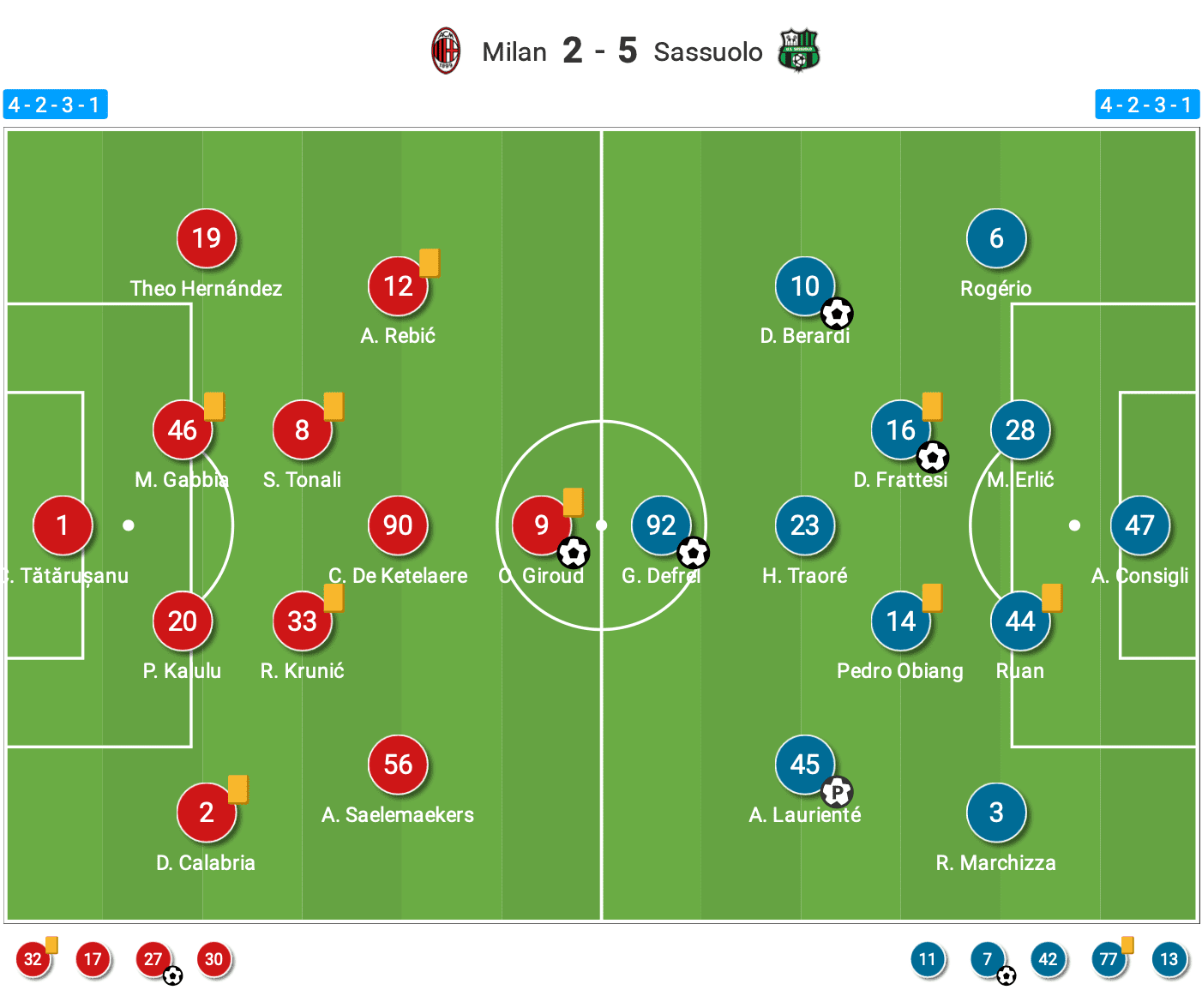
Dionisi has shown remarkable versatility in terms of his ability to switch formations on the fly and in preparation for games. He only utilised this formation 12% of the time this season, but against the champs, it paid off.
Andrea Consigli, 36, was the starter in goal. Riccardo Marchizza and Rogério played on the wings to support the central defensive duo of Martin Erlić and Ruan Tressoldi.
Hamed Traoré, who is close to a move to AFC Bournemouth in the Premier League, is directly above Pedro Obiang and Davide Frattesi in the pecking order. Gregoire Defrel began in the middle, with veteran Domenico Berardi and the 24-year-old Armand Laurienté on the wings.
Milan’s structural disaster
The manner in which Milan managed to defend was inexcusable given that the team’s defensive side crumbled and was unable to rise back up to continue fighting.
The yellow line indicates the defensive line, while the red line indicates the degree of connection between the pivots. When Gabbia presses inadequately, he ends himself in a chasing position with Tonali, who prefers to defend on the sides rather than stay inside with the other pivot.
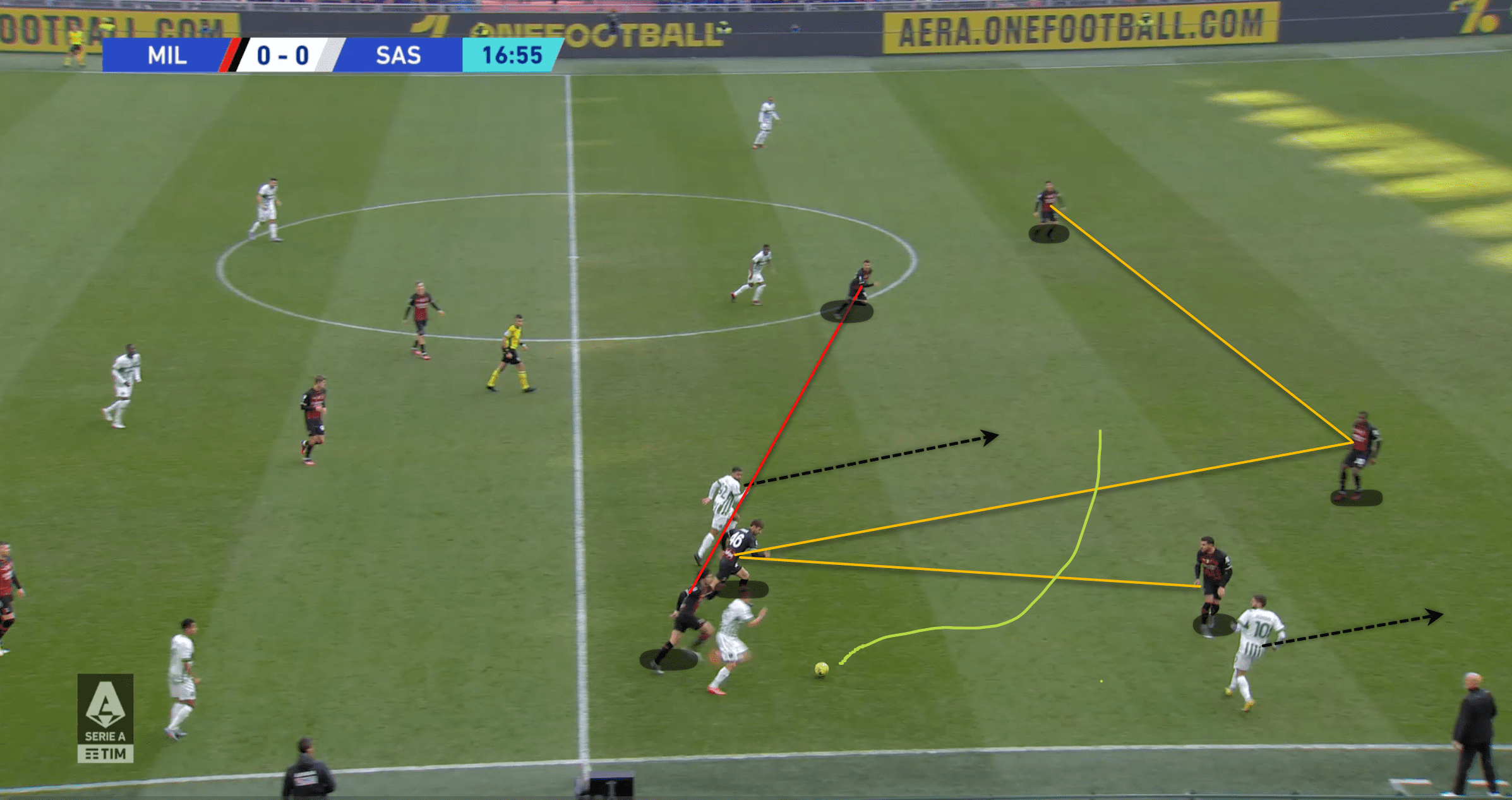
Sassuolo’s spirits were up greatly when their first goal came. Following the first goal and immediately before the second, Milan’s defence broke down, permitting Sassuolo to add another.
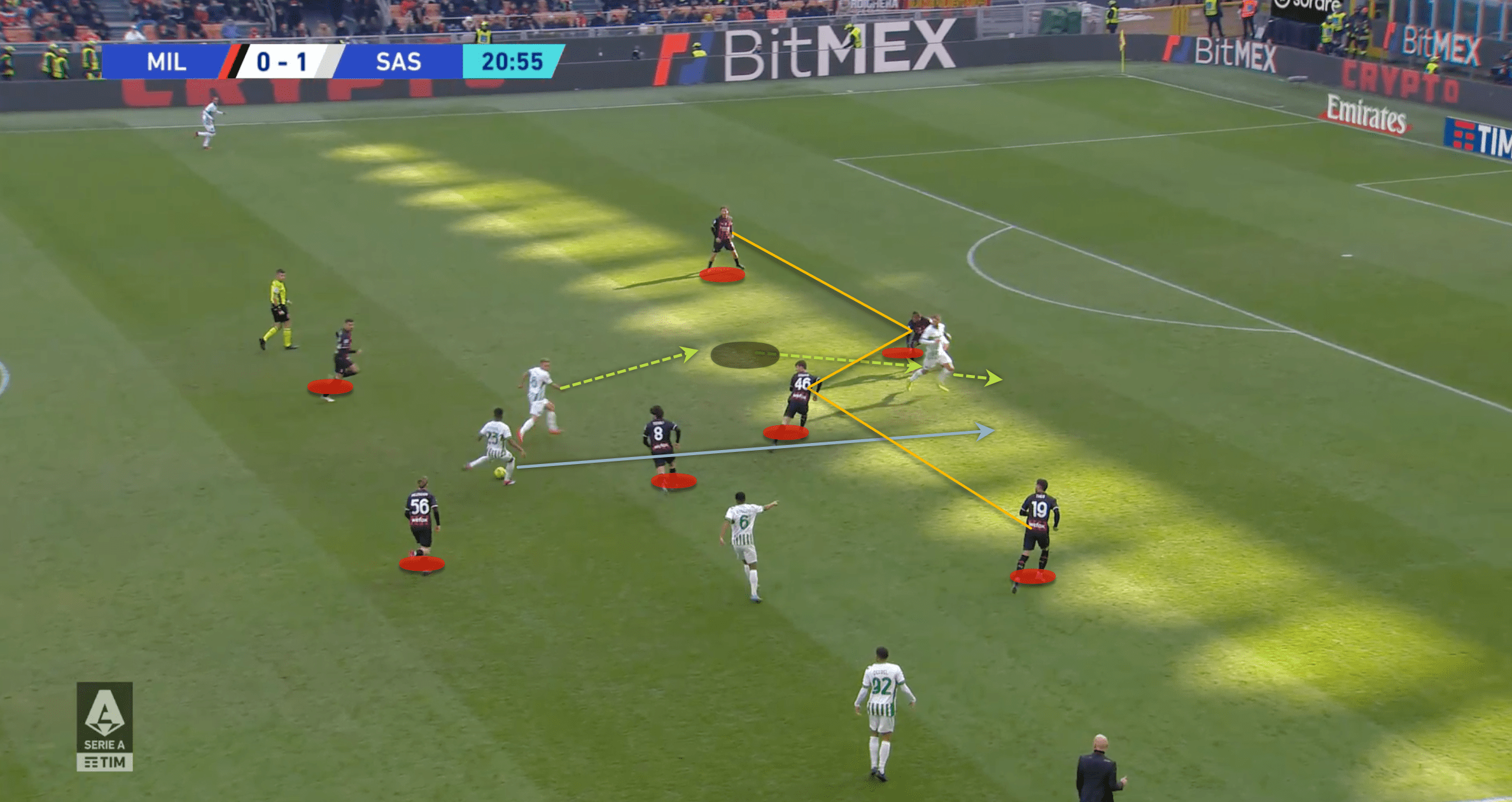
Berardi’s move into the final third would unsettle the central defensive pairing after an ineffective press by Milan’s forward line. Milan is on its last legs in the final third thanks to Berardi’s lovely left foot and his years of expertise.
20 minutes into the match, Sassuolo had dismantled Milan’s defensive unit. The guys under Dionisi’s command are relaxed, while the home team has formed what looks like a heart. It would have been humiliating for the home supporters to see anything like that happen on their turf.
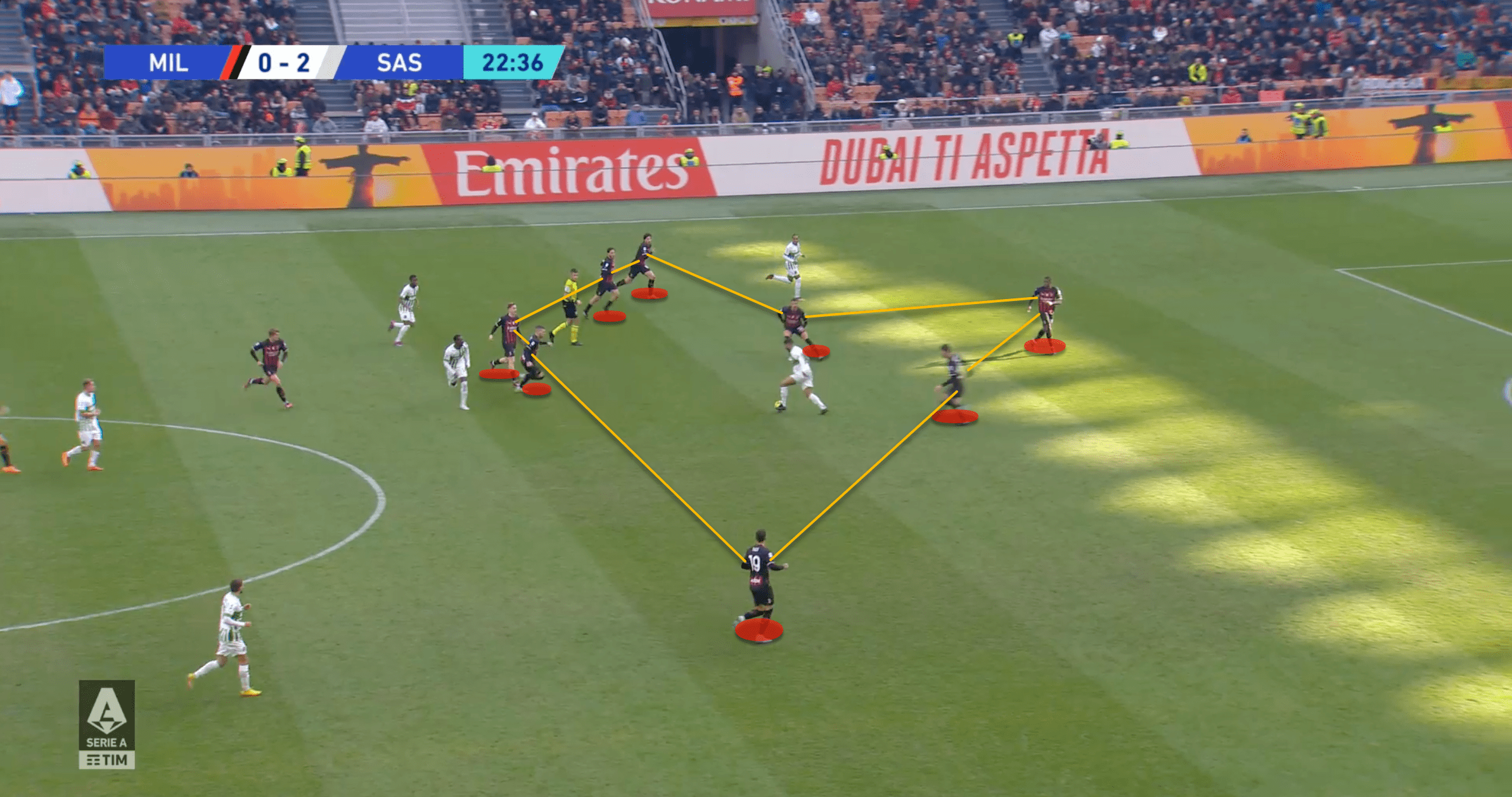
Milan’s defensive connections have been plagued by a shaky midfield. After Krunić left, Tonali and Tomasso Pobega were keen to push and attack aggressively but didn’t know where the weaknesses were.
Sassuolo were quite at ease with keeping the ball up until they found a good passing lane, as shown in the top photo. When they lost the ball while pursuing it, they were left in a four against four situation on Milan’s right side.
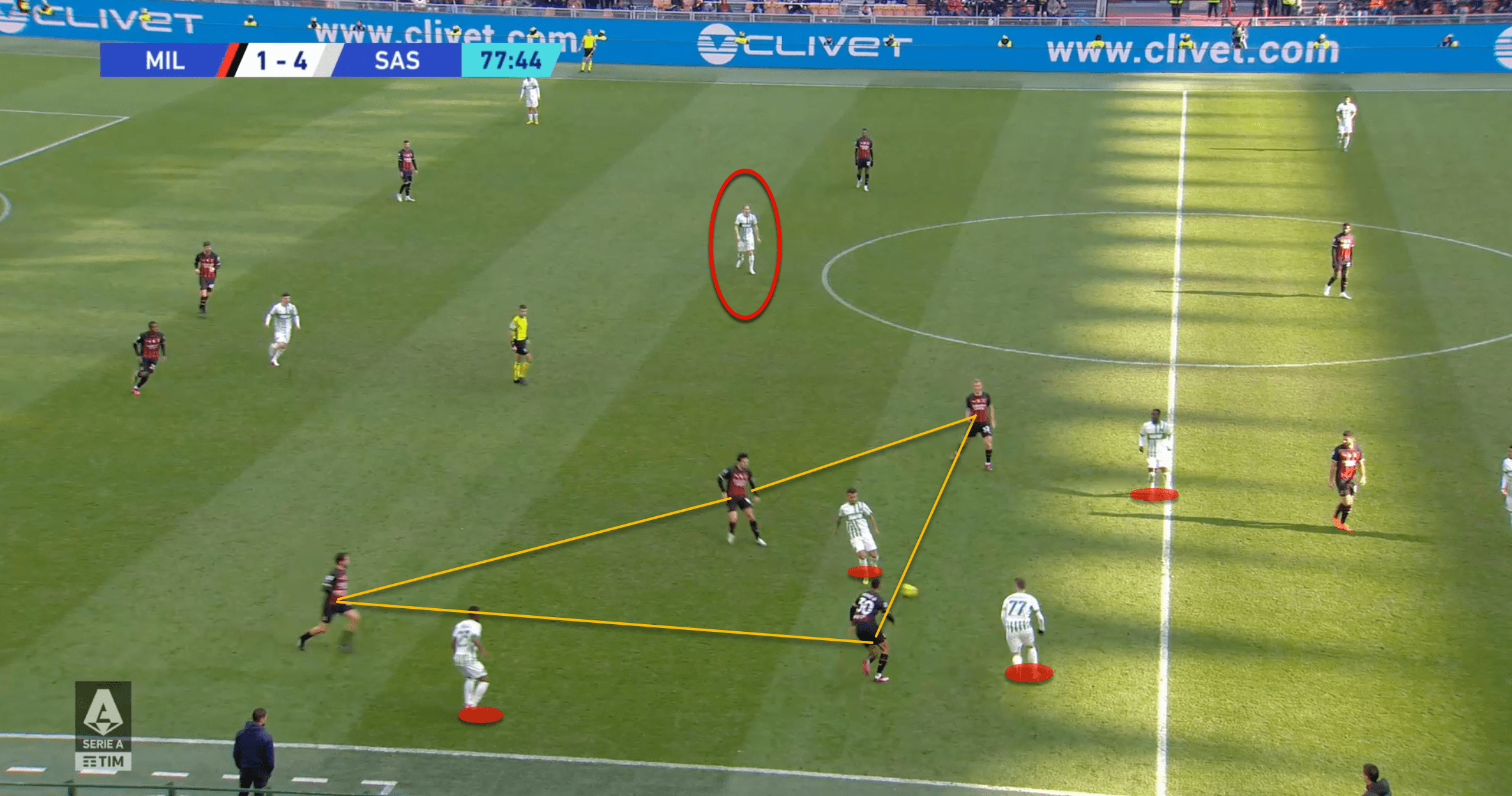
The home team’s woes were compounded by the presence of Kristian Thorstvedt, who was in plain sight and ready to add insult to injury in the middle of the field.
It didn’t matter. All they wanted was the ball to fumble an attack. The current Milan defence must be a huge letdown for Paolo Maldini, former legendary defender and the club’s technical director.
How Sassuolo made Milan’s press look worthless
The offence lacked aggressive pressing with Giroud at the top of the lineup. Pioli planned to send De Ketelaere, the attacking midfielder who would position himself behind the striker.
The best possible outcome would have been achieved with a faultless execution of this exchange. The defensive midfielder in the picture above had to come up against Obiang, but it worked out nicely for Dionisi’s team since it forced Obiang to respond the first time.
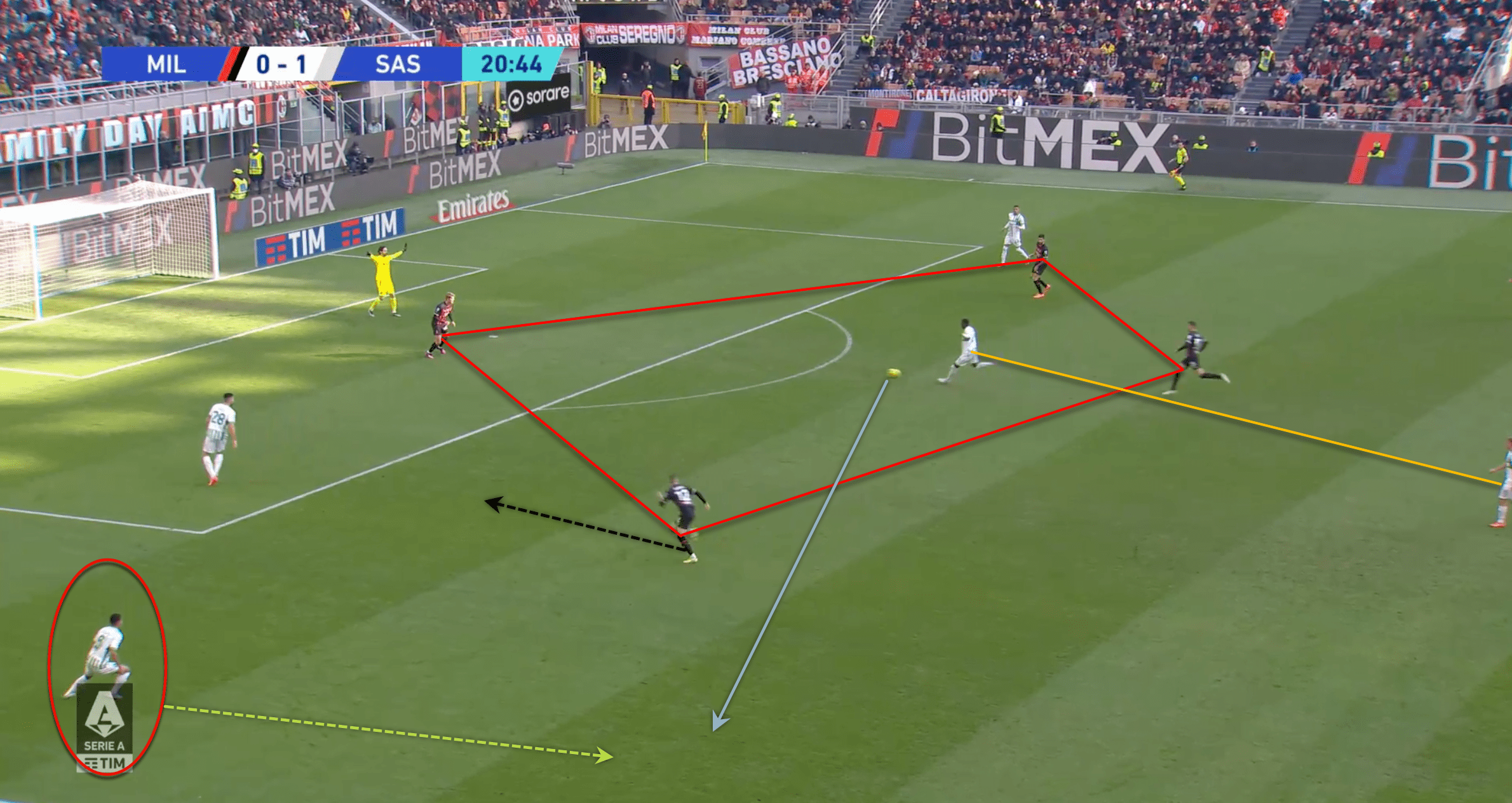
Dionisi’s strategy of positioning the pivots in a certain manner was quite successful. In the pre-event phases, when they were both facing the press, Obiang and Frattesi kept their distance.
To the left flank, Rebić fails to see the open Rogério and instead looks for the centre-back. Obiang’s awareness and the style he adapts seem to be that of Brighton & Hove Albion’s Moisés Caicedo.
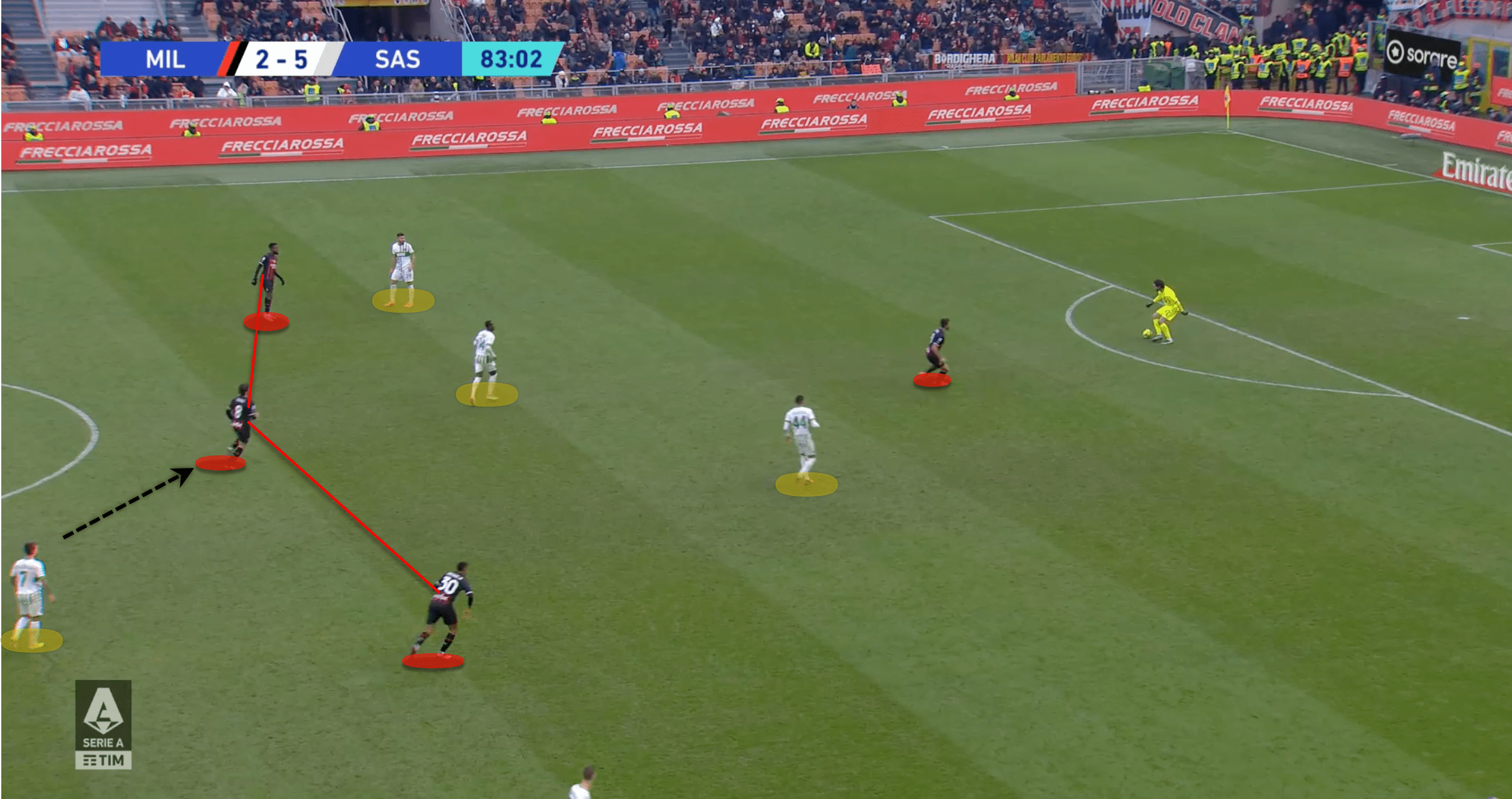
To compensate for Giroud’s pressing the keeper, Tonali had to shift up into the offensive midfield position, making way for Matheus (number 7) in the above image.
The right flank for Sassuolo was the main outlet to go through at any point in the game. Berardi’s support down the right side with Rogério’s attacking mentality combined well to erupt attacks.

Sassuolo only sparkled when they were pressed and had to play first-time passes to beat the press. This is where the players stood out. Even after Milan conceded four inside sixty minutes, they wanted to press high and win the ball which they weren’t capable of until they cleared.
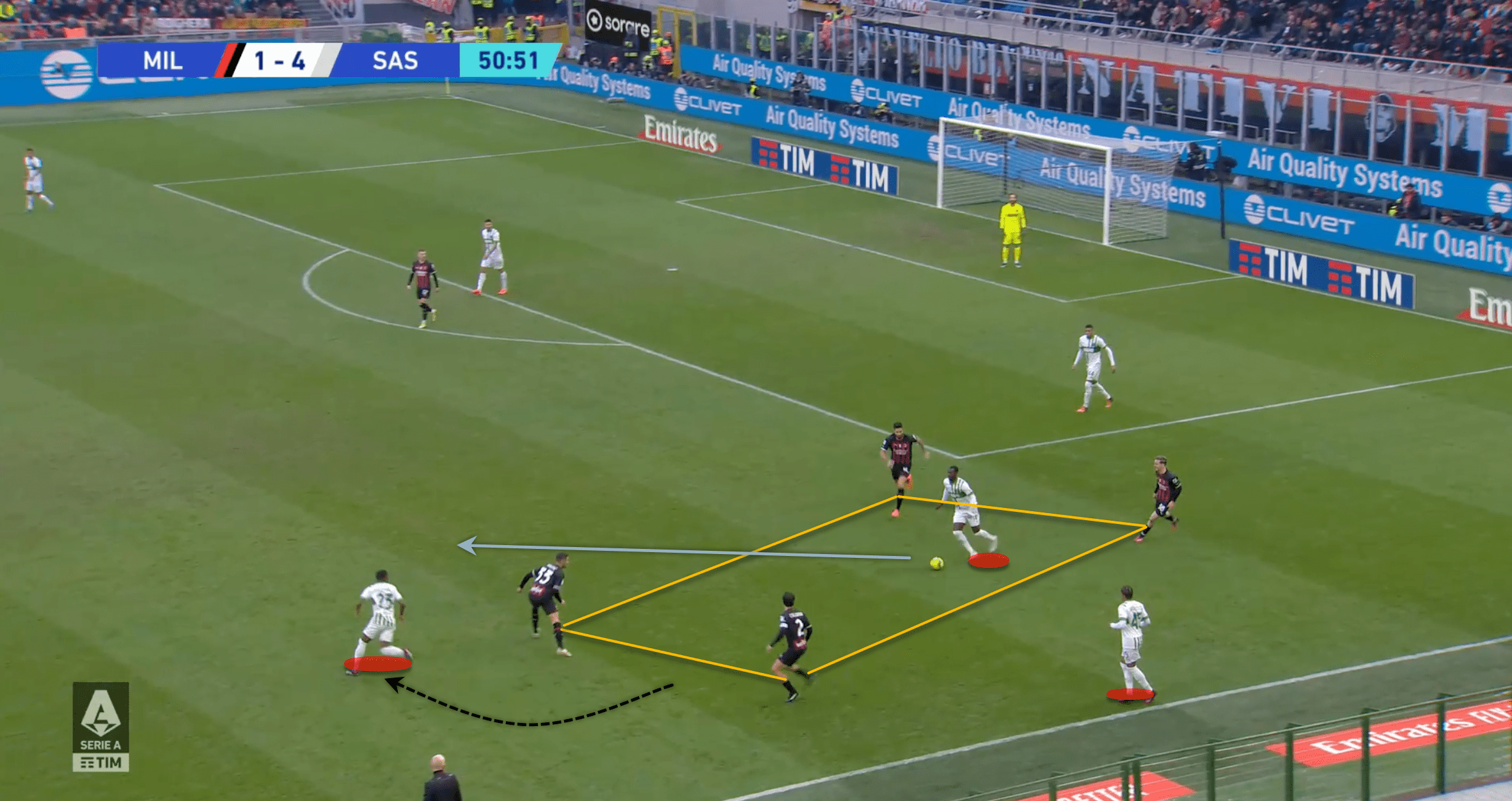
Traoré’s introduction seemed to keep Dionisi’s players engaged until the final whistle, as he was able to go behind his marker and collect a pass. In the top image, you can see him running behind Krunić to get into a better shooting position.
Calabria’s right-wing press alongside his teammates didn’t appear to do much as Obiang, Hamed Traoré, and Laurienté easily produced connections and controlled the tempo. To put an end to Milan’s pressing, they seemed to have individual energy, but they didn’t work well enough together.
Sassuolo’s compact defending
Dionisi has already demonstrated that he is capable of using a 5-3-2 or a 5-4-1 to close out games and improve his team’s defensive stability, as well as the 4-4-1-1 and 4-3-2-1 on occasions.
Below is a picture late in the game where Sassuolo subtly shifted to a 4-1-4-1 with just Obiang in the centre. This seemed to invariably chase off half of Milan’s attack.
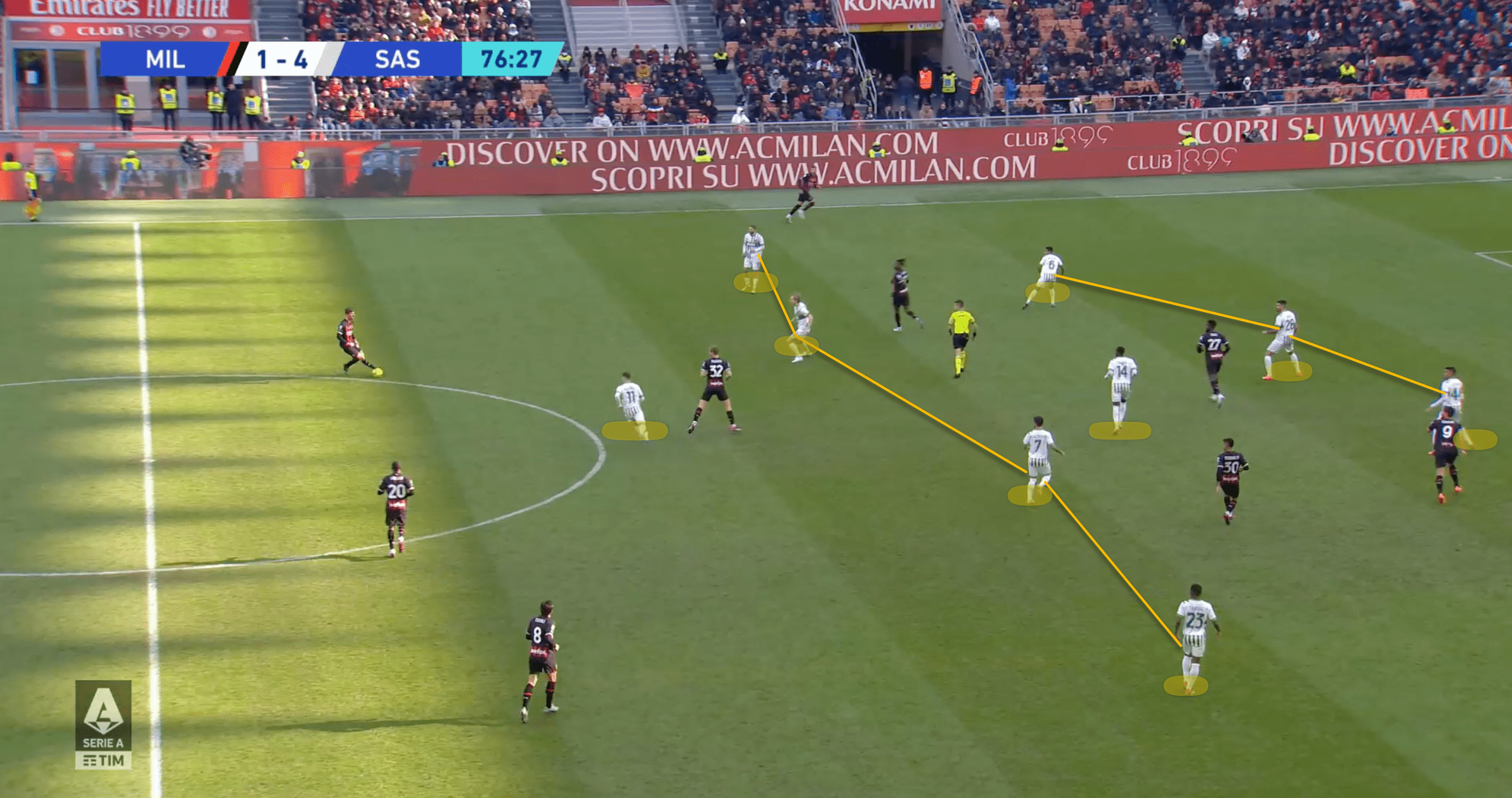
Milan’s poor ball control was evident in their inability to effectively combine and make ground passes. Instead, they aimlessly threw long balls without any sense of direction or belief.
To reciprocate Milan’s attacks, Dionisi’s men needed to work together and be cautious. That pretty much summed up Sassuolo’s whole defence strategy.
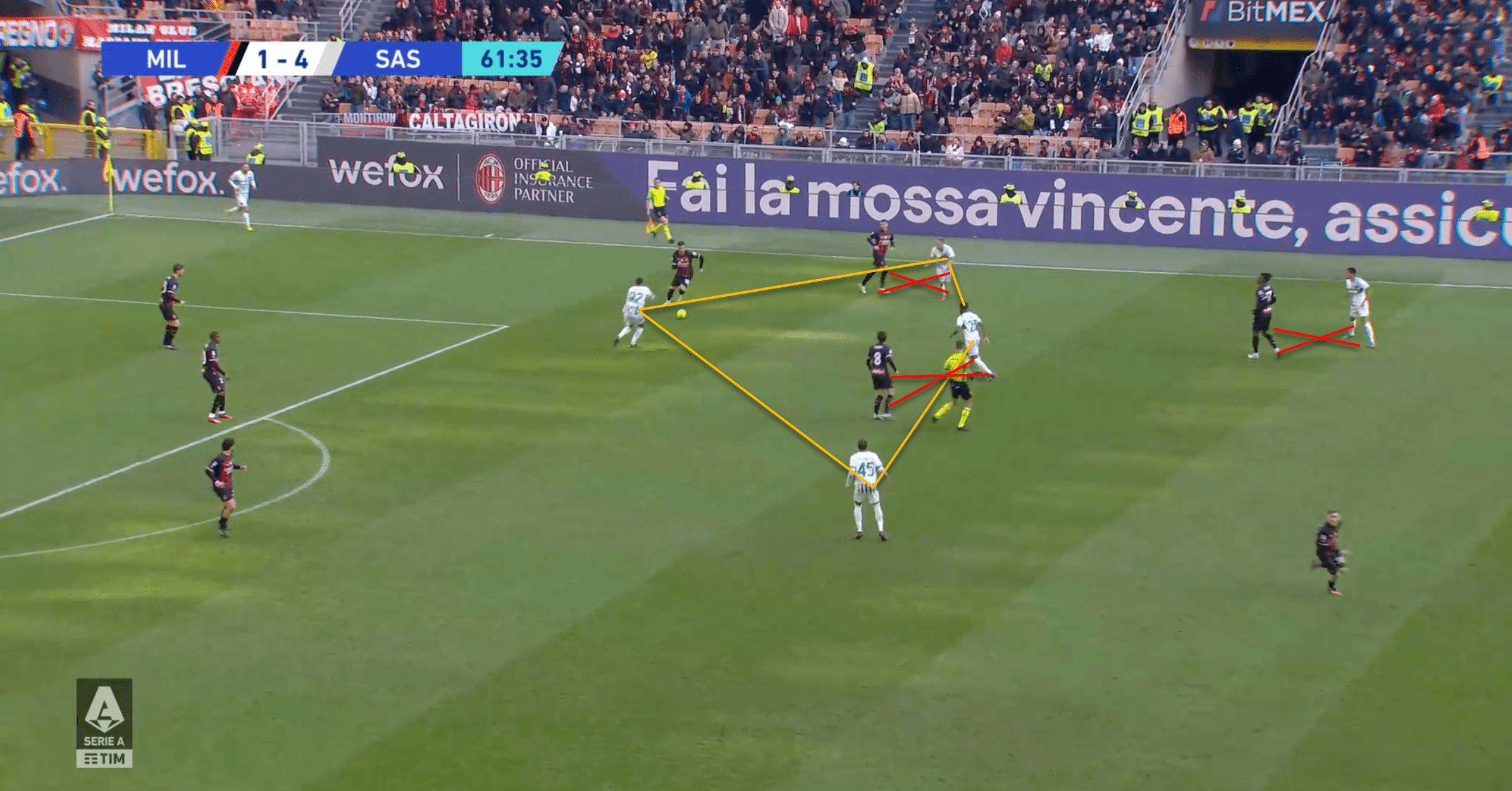
Whenever Milan gave room for Sassuolo’s press, the tight marking disallowed fullbacks’ efforts to come inside and make the play. Rafael Leão who had come on later in the game is seen marked and Tonali in the centre of a four man structure.
Stefano Pioli’s tactical approach has been significantly responsible for AC Milan’s recent success. The fullbacks in the Italian manager’s 4-2-3-1 lineup play more forward positions.
When compared to Sassuolo’s tight organisation, Milan’s inability to extend the attack and come from the flanks made them even less formidable.
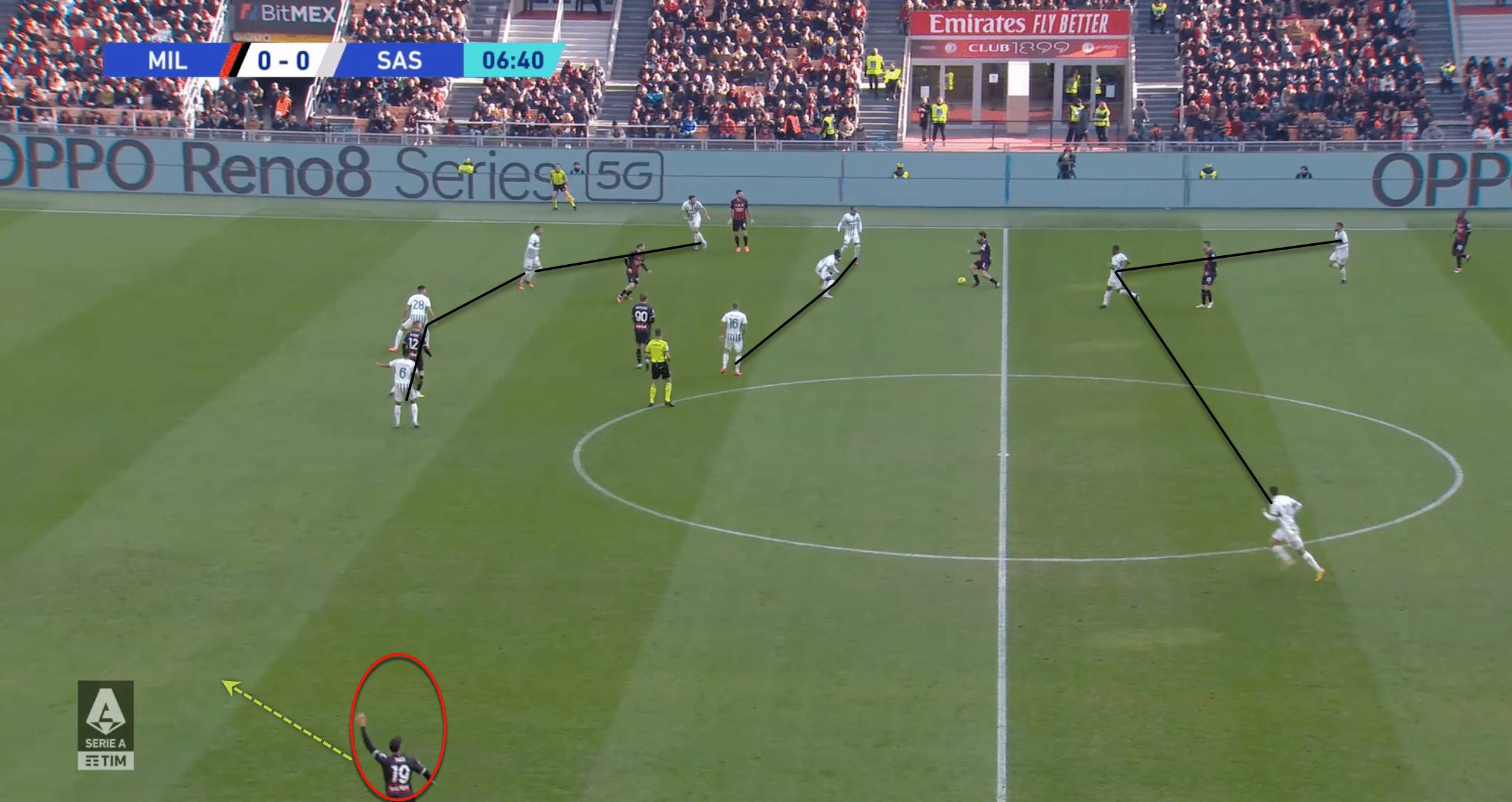
Only Hernández at the left extreme could make a difference to the team’s attacking tendency. Whenever left alone, his desire to go up was ideally the key to most of the chances Milan were able to generate.
Whenever they pressed, the aim was to fulfil the coach’s instructions. Dionisi’s idea on how to press was to tightly mark and apply some physicality to demoralise the opponents.
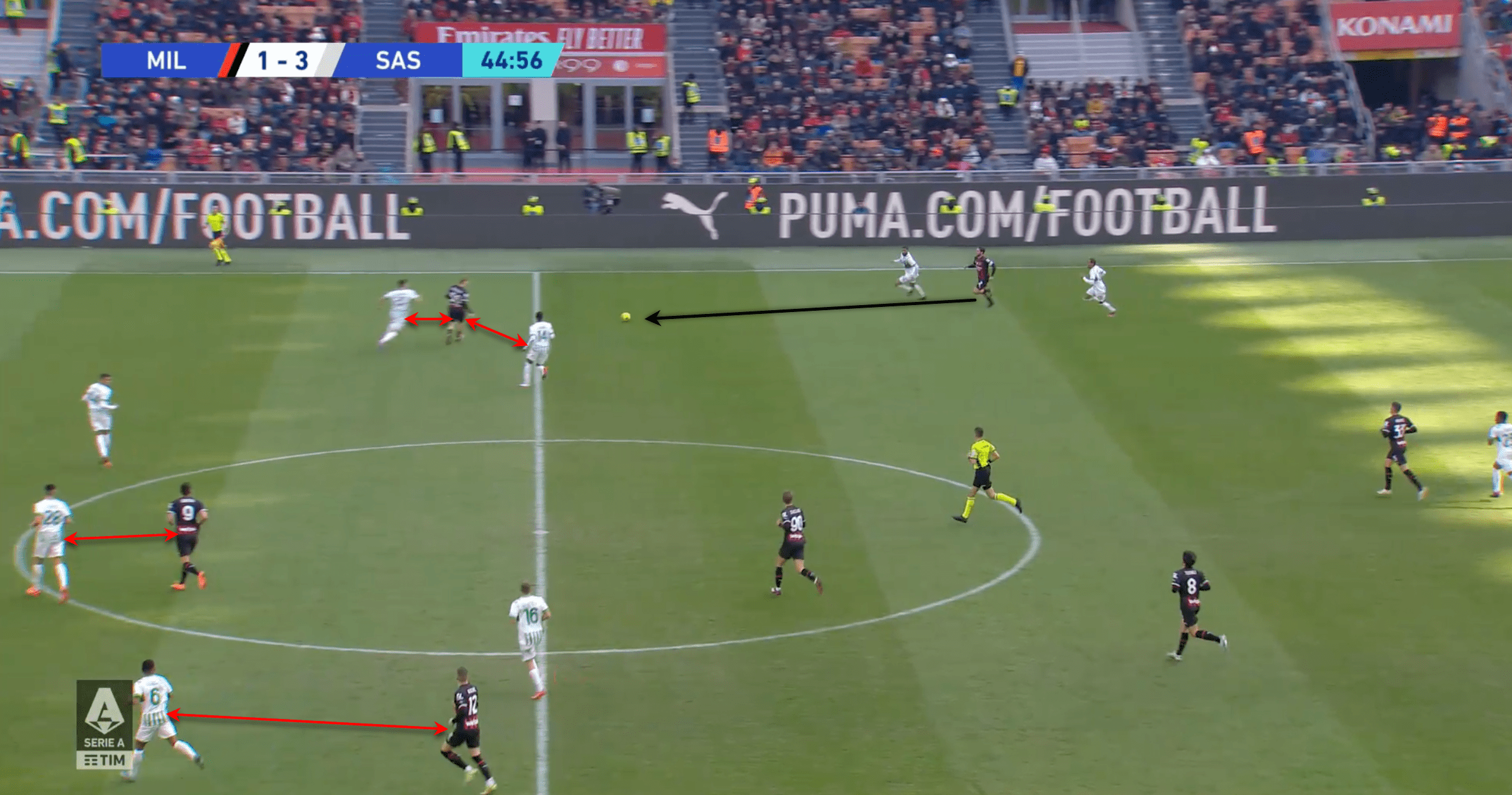
In the top shot, we see two Sassuolo players doubling up on the receiver even before the ball lands on his feet. The marked arrows depict how Dionisi wanted his defenders to tighten the gap.
Milan had more shots than Sassuolo, with 11 total shots and 5 on target, but the xG gap was massive. Sassuolo had just 9 shots, with only 7 on target. Incredible 2.14 for Dionisi’s men vs only 0.60 for the Rossoneri.
When beginning their attacks from a deeper position, Pioli’s team had twice as many shots as their opponents. Compared to Sassuolo’s 23 efforts, just 5 resulted in shots for Milan’s 35 attempts but 10 finished with a shot.
Conclusion
Dominic Berardi racked up four goal contributions out of the total five against the Rossoneris. Berardi, being in the middle of everything, helped Dionisi’s best-ever display against a side like the defending champions.
In conclusion, Dionisi is a risk-taker as a coach, but the high level of entertainment provided by Sassuolo games is well worth the potential downside.
On the other hand, Milan have been boring to watch as of late, but Dionisi from the cake got the slice he deserved. Pioli’s pressure is escalating after he suffered his fourth loss in the past five games.
Moreover, to add to Milan’s luck, due to offsides, VAR overturned two of Milan’s goals, one from Giroud and another from Rebic.
After Pioli’s men knew they had no say in the game, they started doing foul after foul as frustrations grew. Almost seven of Pioli’s men saw yellow whereas the visitors only saw four.
Armand Laurienté scored a penalty kick only two minutes into the second half, and Matheus Henrique tacked on a fifth goal just after 11 minutes, adding to Milan’s misery.
Thanks to their crushing victory, Sassuolo now have a comfortable eight-point cushion over the bottom of the standings and are well on their way to a radical transformation under their young manager.





Comments